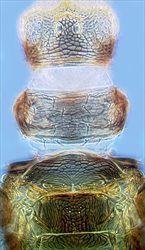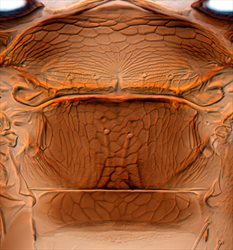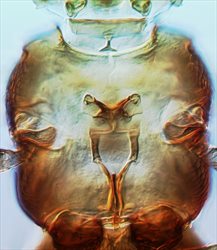
Female

Head & thorax

Head

Antenna

Antennal segments IV-V

Tergites VII-X

Mesonotum & metanotum

Thoracic furcae

Fore wing
Both sexes fully winged. Body brown, head with pair of yellow longitudinal areas; legs yellow, mid and hind femora brown; III–V largely yellow; fore wing brown but pale at apex and sub-basally, and with submedian area variably lighter. Antennae 8-segmented, VIII more than twice as long as VII; III and IV with short forked sense cone that extends scarcely beyond segment apex. Head reticulate with transverse occipital ridge; ocellar setae III on anterior margins of triangle; three pairs of postocular setae present. Pronotum with no long setae. Metanotum reticulate medially, median setae arise medially; metathoracic furca long and U-shaped. Tarsi all 2-segmented. Fore wing with two complete rows of setae, posteromarginal cilia wavy. Abdominal tergites weakly reticulate medially, median pair of setae small; posterior margins without a craspedum, VIII with comb of microtrichia laterally; tergite X with longitudinal split almost complete.
Male with sternal marginal setae minute. Sternites III–VII with slender transverse pore plate.
Nine species are recognized in the genus Hercinothrips, all of them originally from Africa. Two species, H. bicinctus and H. femoralis, are now widespread around the world, and a third species H. dimidiatus was found in Portugal in 2015 causing damage to cultivated Aloe arborescens (Mateus et al., 2015), and subsequently under glass in the Netherlands on A.vera. H. femoralis is very similar to H. bicintus, but has the fore wings more extensively dark medially. Hercinothrips species are unusual amongst Panchaetothripinae in having 2-segmented tarsi, and the fore wing with both longitudinal veins bearing a complete row of setae.
Breeding and pupating on leaves, this species attacks many different and unrelated ornamental plant species in greenhouses in temperate regions. It is sometimes referred to as the Sugar Beet Thrips or the Banded Greenhouse Thrips.
Originally from Africa, H. femoralis is occasionally found under glass in Britain (Mound et al., 1976) and in Europe (zur Strassen, 2003), but it is widespread around the world in tropical and subtropical areas.
THRIPIDAE - PANCHAETOTHRIPINAE
Hercinothrips femoralis (Reuter)
Heliothrips femoralis Reuter, 1891: 166
Heliothrips cestri Pergande, 1895: 390
Heliothrips apicalis Bondar, 1931: 86
Mateus C, Franco JC, Caetano MF, Borges de Silva E, Ramos AP, Figueiredo E & Mound L (2015) Hercinothrips dimidiatus Hood (Thysanoptera: Thripidae), a new pest of Aloe arborescens in Europe. Phytoparasitica 43 (5): 689–692.
Mound LA, Morison GD, Pitkin BR & Palmer JM (1976) Thysanoptera. Handbooks for the Identification of British Insects 1 (11): 1–79.
zur Strassen R (2003) Die terebranten Thysanopteren Europas und des Mittelmeer-Gebietes. Die Tierwelt Deutschlands 74: 1–271.